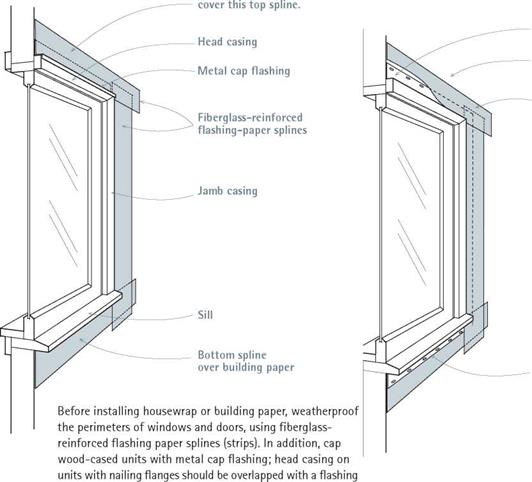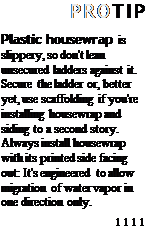Exteriors
The exterior і multi
layered membrane, weatherproofing the house much the way a roof does. In addition to protecting underlying elements from damage by sun and wind, the exterior intercepts and directs water away from the underlying sheathing and framing. The visible exterior layer consists of siding and trim. Beneath the siding, ideally, is either building paper or plastic housewrap, which is relatively water repellent. In addition, flashings seal transitions from one material to another or redirect water around potential dams, such as window and door headers, vent fans, and outdoor outlets. Finally, various sealants fill gaps, adhere materials, or cut air infiltration. Of course, windows and doors are exterior elements, too. But as “openings” in the exterior, they are the principal subjects of Chapter 6.
Although drain gutters may be considered part of the roof, they are discussed at the end of this chapter because gutters “attach to” and protect the exterior. Gutters also direct water away from foundations, thus reducing moisture there and mold in basements and crawl spaces while preventing excess water from undermining foundations.
As with other building systems, maintenance is crucial. Each autumn after the leaves have fallen and each spring, clean gutters and downspouts; if needed, do this more often to keep them flowing freely. Every year, survey and recaulk building seams as needed. Paint or stain wood siding periodically. Trim trees and shrubs so they don’t retain moisture next to the siding or restrict air circulation. Slope the soil away from the foundation to help direct water away. Adjust lawn sprinklers so they don’t spray siding.
|
|
■В? > .. *‘чС* .. |
‘■ – иди |
|
|
* Ы Ужі |
1 |
|
|
g wj I As;1′ |
 WOOD-CASED WINDOW
WOOD-CASED WINDOW
|
|
|
|
|
|
|
|
|

No matter how well siding is installed, sooner or later water will work its way behind. Typically this happens when storms drive rain into building seams or gaps around doors or windows. But water can also be drawn inward and even upward by capillary action before trickling down behind siding. For these reasons, builders protect exterior sheathing with building paper (15-lb. building paper is most common) or plastic housewraps such as Tyvek® or R-Wrap® to repel water.
Both building paper and plastic housewrap do a good job of reducing air infiltration. That is, both are permeable enough to allow excessive moisture behind the siding to escape, and both are sufficiently water repellent to protect sheathing from wind-driven rain. Bottom line: It doesn’t matter whether you use building paper or house – wrap, as long as it’s correctly installed and conforms to local building codes, which may require
that they are compatible with finish materials. For example, beneath stucco, many building codes require a double layer of Grade D kraft paper or a fortified paper such as Fortifiber’s Super Jumbo Tex® 60 Minute.
Typically, this weatherproofing membrane is installed after windows and doors have been installed and their perimeters weatherproofed with fiberglass-reinforced flashing paper. As shown in "Wood-cased window,” above, building paper overlays cap flashing and fits under the sill flashing. Cap flashing, also called head flashing, is especially important because it redirects water that might otherwise dam behind a door or window head casing, leading to stains and mold on interior surfaces, swollen sashes, peeling paint, and rot.
Replacing all siding, flashing, and building paper is the surest way correct such water-related damage, but if that’s not in your budget, retro-
 fitting flashing around individual windows and doors may do the trick. In that case, cut back the siding far enough around the perimeter of the door or window to install 6-in.-wide flashing paper, as described next.
fitting flashing around individual windows and doors may do the trick. In that case, cut back the siding far enough around the perimeter of the door or window to install 6-in.-wide flashing paper, as described next.






Leave a reply